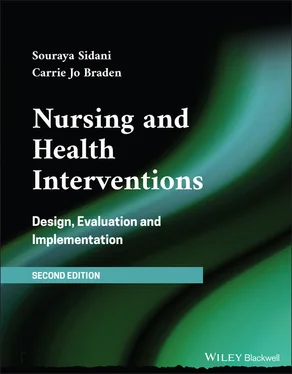After all group sessions are completed, the quantitative ratings are analyzed descriptively to determine the most relevant and important indicators and determinants (indicated by high means and low variances). The transcripts of the qualitative comments are content analyzed. A matrix is used to integrate quantitative and qualitative findings and identify the most relevant indicator of the health problem, the most important determinants, how the determinants contribute to the problem, and possible differences across subgroups of the target population. The application of this method is illustrated in Sidani et al. (2018b) who found that Chinese Canadians experience insomnia as difficulty initiating sleep, which they attribute to high levels of stress.
The first step of the integrative strategy for cultural adaptation of interventions has the same advantages as concept mapping. However, its application is less cognitively burdensome.
Integration of the quantitative and qualitative data may be challenging.
3.3.3.4 Strengths and Limitations
The experiential approach is a useful means for accessing the implicit theory or conceptualization of the health problem held by client populations, in contexts not represented or investigated in previous studies, as is often the case with marginalized groups or ethno‐cultural communities (Buffel, 2018). However, this approach has some limitations related to the selection of the target population members and the size of the participating group. These limitations may lead to unrepresentative sample, yielding potentially biased results that may not be applicable to all subgroups of the target population.
3.3.4 Combined Approach for Understanding the Problem
3.3.4.1 Overview
Each of the theoretical, empirical, and experiential approach is useful in gaining insights about the health problem. However, each approach has limitations. Combining the three approaches is recommended to overcome the limitations, and is applied in the first step of the intervention mapping process. Intervention mapping is a process for designing behavioral interventions (Bartholomew et al., 2016), which is described in more detail in Chapter 4. The first step in intervention mapping focuses on the analysis of the problem to clearly specify the individual and contextual determinants of the problem. This is accomplished by applying the three approaches concurrently or sequentially, and integrating the theoretical, empirical, and experiential information to generate the theory or logic model of the problem.
As described by Bartholomew et al. (2016) and Kok et al. (2016), and implemented by numerous researchers, the first step of intervention mapping involves:
Identification of the health problem or behavior in need of remediation, that is, clarification of what needs to be changed and for whom.
Search for theoretical and empirical evidence to gain an understanding of the problem or behavior and its determinants. Determinants are reasons or causes of the problem or (non)engagement in the behavior, commonly occurring at the individual client (e.g. cognitions, emotions, beliefs) or context (e.g. social norms) levels. Different types of reviews have been conducted such as rapid reviews (e.g. Baker et al., 2018), systematic reviews (e.g. Brendryen et al., 2013), scoping reviews (e.g. Dalager et al., 2019), and narrative reviews (e.g. Athilingam et al., 2018; Beck et al., 2018; Besharati et al., 2017).
Integration of theoretical and empirical evidence into a comprehensive list of factors contributing to the problem or behavior.
Engagement of stakeholder groups (e.g. clients, community leaders, health professionals) in events or activities aimed to explore the relevance of the determinants, identified from the literature, to the target client population and context. A range of activities have been used including: individual interviews with stakeholders (e.g. Baker et al., 2018; Beck et al., 2018), focus group discussions (e.g. Ammendolia et al., 2016; Besharati et al., 2017), roundtable meetings, workshops or nominal group techniques (e.g. Johnson et al., 2017; Meng et al., 2019), to review the determinants for their relevance and/or to prioritize the determinants that should be addressed when designing the intervention.
Refinement of the theory or logic model of the problem so that it reflects the problem and its determinants, as experienced by the target client population.
Combining the theoretical, empirical, and experiential approaches, as recommended in intervention mapping, provides complementary and supplementary information for developing the theory of the problem and for refining it to enhance its relevance and applicability to the target client population and context.
The drawback of this combined approach is that it is time consuming and labor intensive.
Regardless of the approach used, the theory of the health problem forms the foundation for designing interventions, as explained in the next chapter.
1 Ammendolia, C., Côté, P., Cancelliere, C., et al. (2016) Healthy and productive workers: Using intervention mapping to design a workplace health promotion and wellness program to improve presenteeism. BMC Public Health, 16, 1190–1207.
2 Aráujo‐Soares, V., Hankonen, N., Presseau, J., Rodrigues, A., & Sniehotta, F.F. (2018) Developing behavior change interventions for self‐management in chronic illness. European Psychologist, 24(1), 7–25.
3 Armstrong, D. & Dregan, A (2014) A population‐based investigation into the self‐reported reasons for sleep problems. PLoS One, 9(7), e101368.
4 Athilingam, P., Clochesy, J.M., & Labrador, M.A. (2018) Intervention mapping approach in the design of an interactive mobile health application to improve self‐care in heart failure. Computers, Informatics, Nursing, 36(2), 90–97.
5 Baker, P., Coole, C., Drummond, A., et al. (2018) Development of an occupational advice intervention for patients undergoing lower limb arthroplasty (the OPAL study). Health Services Research, 18, 504–511.
6 Ball, L., Ball, D., Leveritt, M., et al. (2017) Using logic models to enhance the methodological quality of primary health‐care interventions: Guidance from an intervention to promote nutrition care by general practitioners and practice nurses. Australian Journal of Primary Health, 23, 53–60.
7 Bartholomew, L.K., Kok, G., & Markham, C.M. (2016) Planning Health Promotion Programs: An Intervention Mapping Approach (4th ed). John Wiley and Amp; Sons Inc, New York.
8 Baur, N. (2019). Linearity vs circularity? On some common misconceptions on the differences in the research process in qualitative and quantitative research. Frontiers in Education, 4, 53–67.
9 Beall, R.F., Baskerville, N., Golfam, M., Saeed, S., & Little, J. (2014) Modes of delivery in prevention intervention studies: A rapid review. European Journal of Clinical Investigation, 44(7), 688–696.
10 Beck, D., Been‐Dahmen, J., Peeters, M., et al. (2018) A nurse‐led self‐management support intervention (ZENN) for kidney transplant recipients using intervention mapping: Protocol for a mixed‐methods feasibility study. JMIR Research Protocols, 8(3), e11856
11 Besharati, F., Karimi‐Shahanjarini, A., Hazavehei, S.M.M., et al. (2017) Development of a colorectal cancer screening intervention for Iranian adults: Appling intervention mapping. Asian Pacific Journal of Cancer Prevention, 18(8), 2193–2199.
12 Bleijenberg, N., de Man‐van Ginkel, J.M., Trappenburg, J.C.A., et al. (2018) Increasing value and reducing waste by optimizing the development of complex interventions: Enriching the development phase of the Medical Research Council (MRC) framework. International Journal of Nursing Studies, 79, 86–93
Читать дальше












